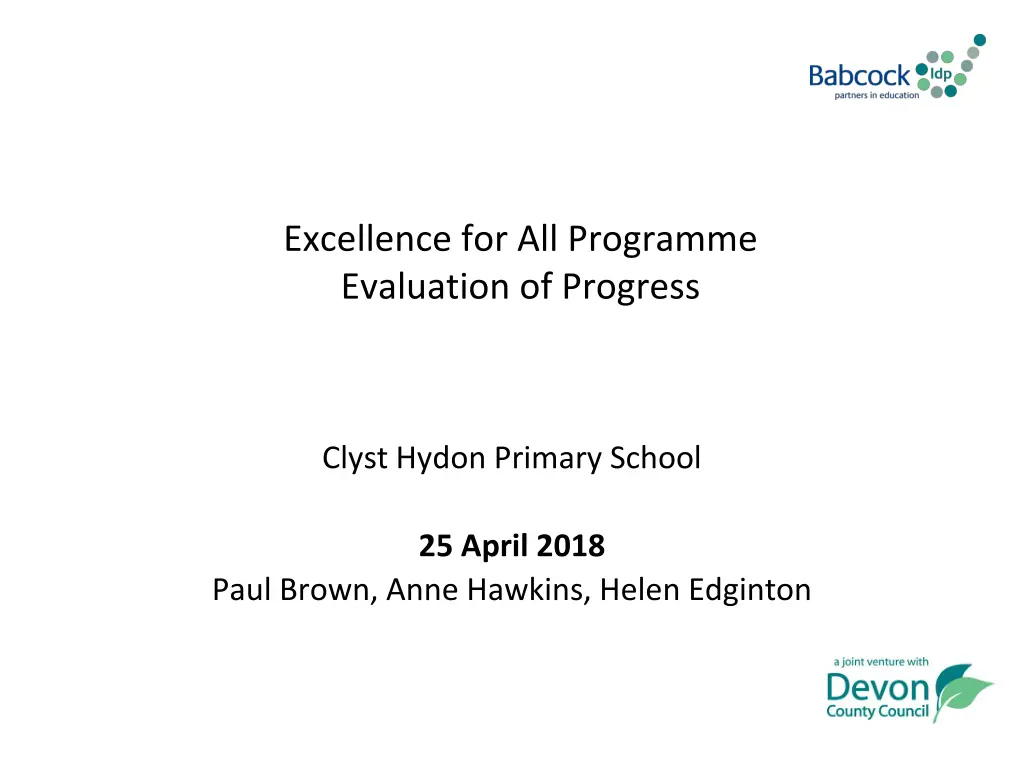
Evaluation of Progress at Clyst Hydon Primary School
"Discover the progress evaluation report of Clyst Hydon Primary School, highlighting improvements and challenges in teaching, learning, assessment, and student development. Explore the strengths and areas for improvement as the school works towards achieving excellence for all students. Follow the transformation journey led by dedicated educators and supportive partnerships."
Download Presentation

Please find below an Image/Link to download the presentation.
The content on the website is provided AS IS for your information and personal use only. It may not be sold, licensed, or shared on other websites without obtaining consent from the author. If you encounter any issues during the download, it is possible that the publisher has removed the file from their server.
You are allowed to download the files provided on this website for personal or commercial use, subject to the condition that they are used lawfully. All files are the property of their respective owners.
The content on the website is provided AS IS for your information and personal use only. It may not be sold, licensed, or shared on other websites without obtaining consent from the author.
E N D
Presentation Transcript
Excellence for All Programme Evaluation of Progress Clyst Hydon Primary School 25 April 2018 Paul Brown, Anne Hawkins, Helen Edginton
Context Clyst Hydon is a small rural school of three classes. Reception children, Year 1 and Year 2 pupils are taught in one class, Year 3 and Year 4 pupils are taught together, with Year 5 and Year 6 pupils also being taught together. The number of children in the early years provision has been below five since the last inspection. The school was inspected on 9th February 2017 and judged to require improvement. The school was previously inspected on 26 Jun 2013 and was judged to be outstanding. The school has undergone considerable change since the previous inspection and since September 2016. The school has recently moved quickly into a new management partnership with the Ventrus MAT, following the conclusion of the previous partnership with Cullompton Community College. Ventrus has provided an acting Head of School and a Director of School Improvement The acting Head of School has made a strong and enthusiastic start. She is well-supported by Ventrus. The MAT is providing support on several levels for the school . School improvement challenge and support, is being provided by the Ventrus Directors of School Improvement. The school will continue as maintained by the local authority for the summer term and therefore remain subject to further evaluation visits under the Excellence for All programme The target date for the school to be judged good is 11 July 2018. This is the third evaluation visit since the inspection.
Quality of teaching, learning and assessment The quality of teaching, learning and assessment requires improvement to be good. But there are many strengths and improvements, since the last review. The overall quality of teaching across the school, has improved significantly since the last evaluation visit Strengths: Pupils are engaged with their learning and are keen to do their best. Pupils show good levels of resilience and are keen to take on challenge. The expectations of teachers has been raised, particularly in KS1 and LKS2. Pupils work in books shows evidence of formative marking, that supports progress in their learning. This has improved further since the last visit. Evidence of assessment for learning in lessons. Elicitation tasks, questioning strategies and challenging misconceptions are more consistent across the school. Pupils were given opportunity to discuss problems in pairs and actively involved in decision making (Maths) There is a greater level of consistency of teaching that leads to good learning. Key challenges: By July 2018 To fully embed high expectations in all lessons Continue to develop the quality of learning in science and the wider curriculum
Personal development, behaviour and welfare of pupils Pupils behaviour is good Pupils personal development is good. This has also improved further since the last evaluation visit. Strengths: Pupils show great respect to each other and are able to demonstrate the social conventions of talking and listening. appear confident and are willing to participate in lessons and read out loud when asked. feel safe and are kept safe in school. demonstrate greater independence since the last visit, so that they are able to maximise their learning time by making decisions for themselves. Demonstrate pride in their work, as a result of the greater challenges and richer experiences in lessons Pupils show good levels of resilience and are keen to take on challenge. Key challenges: By July 2018 Pupils to continue to develop independence and an awareness of what is required to be a good learner
Outcomes for pupils The outcomes for pupils requires improvement to be good. But there is evidence of improvement since the last visit. Strengths: In 2017, Attainment at Key Stage 2 at the nationally expected level and above was 100% for reading, writing and mathematics [RWM]. The cohort numbered 4 pupils, all of whom reached at least the expected standard. In 2017, 2 pupils out of 4 in Key Stage Two attained the higher standard in RWM. This compares with 9% of pupils nationally The school was in the upper 25% of school for progress in reading and the second quartile, between 25% and 50% of schools, for progress in writing and mathematics In 2017, outcomes in science were good. KS1 86% at national standard (83% national) and KS2 100% (82% national) In 2017, of the 7 pupils who undertook the phonics screening check, 71% achieved the expected standard (National 81%). Currently this is assessed at 100% The current progress of pupils from their starting points in Y6 is below expectation, evidenced by the schools own assessment and tracking system. A breakdown across all year groups is provided below. Key challenges by July 2018 In 2017 attainment in KS1 was below national comparisons. Pupils performed significantly less well in Maths. To secure EYFS and KS1 outcomes, so that they compare favourably with national benchmarks( there is insufficient evidence to make a reliable assessment in the EYFS at present) Whilst there has been much improvement, expectations and achievement in lower KS2 needs to continue on an upward trajectory. To fully embed the teaching of science, so that pupils are able to show good progress in their knowledge, skills and understanding of the subject.
Outcomes for disadvantaged pupils Outcomes for disadvantaged pupils is good Strengths: Subject leaders have detailed personal knowledge of these pupils, and use this to provide appropriate levels of support and intervention Progress made from starting points is generally good (see notes below) The gap between the attainment of pupils eligible for the pupil premium and others has narrowed over the past two years Key challenges by July 2018 Ensure that the main barriers to progress in learning are used to evaluate the impact of provision. Middle leaders to continue to develop an evidence base of case studies, to summarise the progress from starting points
Leadership and management The overall effectiveness of leadership and management requires improvement to be good. However, the head of school and Director of school improvement have made a postive impact in a short period of time. Strengths: There is a clear evidence of impact of the new management partnership, which has brought about improvements to teaching, learning and assessment. The new school leaders have made an honest and accurate self-evaluation of the school. The improvement plan is focussed on the key areas. Middle leader of Mathematics, shows enthusiasm and commitment to the school, working diligently to bring about improvements. They have engaged particularly well with external support and are now able to communicate accurately about the progress pupils are making from their starting points and the impact of their actions. This has continued to support pupils learning. Curriculum plans are now in place for English and Maths and are published on the schools website. They provide a basis from which teachers can plan and pupils can make progress in these subjects. However, further development is still required in Science and the wider curriculum. Leaders have improved displays and the environment given the constraints of both time and money. Key challenges by July 2018 Governance still requires improvement to be good. Advisers did not see sufficient evidence of progress since the previous review. Governance is therefore still not effective in holding the school to account. Whilst the governing body has been re- formulated i.e. a new CoG and the addition of two Ventrus Directors, there is still a need to improve the working practices, so that it is effective in it s strategic leadership. The Review of Governance requested by Ofsted(20/04/17), needs reviewing to audit, evaluate and action the areas that need addressing. There was no further evidence of this during the visit. This needs addressing urgently as this will impact on any future evaluation of leadership. Governors should evaluate their roles with reference to the Ofsted school inspection handbook , section relating to leadership & management and action accordingly Safeguarding should be reviewed and updated urgently
Impact of external support The impact of external support is good. Considerable support has been provided through the Ventrus MAT (see footnote) Further support and improvement is required with Governance
Overall progress Target date for school to be judged good: 11thJuly 2018 Capacity for sustaining improvement: Amber The progress the school is making towards being judged good by the target date: Amber

